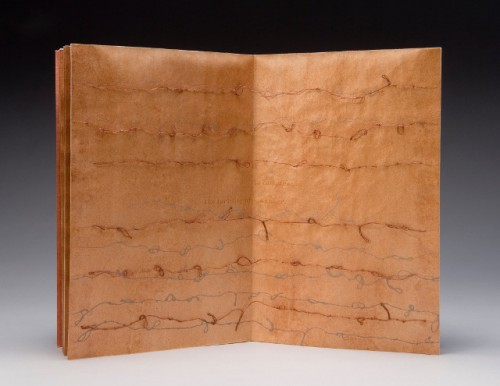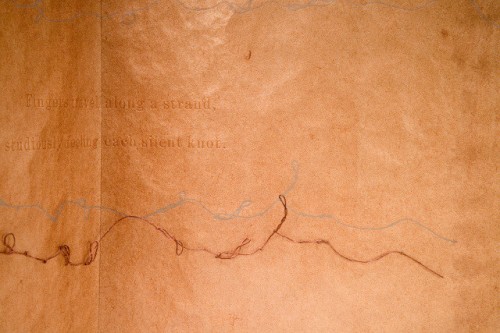The sewing on the outside of the covers of these note books by Sebastian Alvarez is great. Many more examples here
Books that have sewing in them, on them, using thread, weaving, fabric…
The sewing on the outside of the covers of these note books by Sebastian Alvarez is great. Many more examples here
Ines Seidel used teabags and old hymnals to make a new hymn book. She says they make a bit of noise when you turn the pages. See more pictures here.
Kate Bowles sews (she calls it ‘darning’) onto cloth before covering a book. They seem quite beautiful to me. See her blog posts here and here.
When I finished designing my Beuys artist-in-a-box book in January, I had enough material to make 15. I cut out (almost) all the pieces, made 5, and then got side tracked. This month I’m slowly working through my backlog of unfinished projects, and the Beuys book got to the top of the list this week. The matchbox itself is made from a piece of grey Cave paper I bought in 2009 (I even wrote a blog post about it). I’ve taken the sheet out of my drawer countless times, trying to envision the perfect use for it. Patience paid off—this is indeed the perfect book for both the paper weight and color. I’ve so enjoyed the feel of it in my hands as I’ve folded and glued the boxes together.
![]() Here’s a photo of the book in-progress. On the left is very tiny book that is to be encased in felt. The grey rectangle next to it is another book sewn in grey felt—it just needs the red cross sewn on it. Finally on the right is a finished book “package” that goes in the box. Underneath is what the finished matchbox book. See more about the book and more pictures here and here.
Here’s a photo of the book in-progress. On the left is very tiny book that is to be encased in felt. The grey rectangle next to it is another book sewn in grey felt—it just needs the red cross sewn on it. Finally on the right is a finished book “package” that goes in the box. Underneath is what the finished matchbox book. See more about the book and more pictures here and here.
The January word for my prompt challenge book group was asemic: a word for mark-making that resembles writing but actually has no linguistic meaning. From the wikipedia definition: “Asemic writing is a wordless open semantic form of writing. The word asemic means ‘having no specific semantic content’. With the nonspecificity of asemic writing there comes a vacuum of meaning which is left for the reader to fill in and interpret. All of this is similar to the way one would deduce meaning from an abstract work of art.” There are lots of examples on pinterest or this blog.
![]() The word made me remember a book by Macy Chadwick called Letter by Letter. While not asemic writing, it has been the start of my own exploration into the idea of scribbling. She says
The word made me remember a book by Macy Chadwick called Letter by Letter. While not asemic writing, it has been the start of my own exploration into the idea of scribbling. She says
Letter by Letter is about the tactility of language. It was inspired by the String Alphabet for the Blind, from Scotland, 1850, where each knot signifies a letter of the alphabet…letterpress printed with handset type and polymer plates on Mulberry paper treated with persimmon dye. Each page includes a knotted linen thread.
The alphabet is described here as
The string alphabet is formed by so knitting a cord, a ribbon, or the like, that the protuberances made upon it may be qualified by their shape, size, and situation, for signifying the elements of language
![]() Below is a page from Macy’s book, followed by a closeup
Below is a page from Macy’s book, followed by a closeup


On the way to looking for something else, I ran into a post with this wonderful photograph. It’s a book from the Ashmolean Museum in Oxford, and the blog writer says about her visit to the museum:
“One of the most wonderful things, in my opinion, was a huge (C19?) pattern book, full of all the different stencil patterns that could be printed onto fabric to make into a kimono….We also saw some original stencils such as would have been used to make these samples. They were made out of several layers of mulberry paper, and glued together with persimmon tannin. It must have been such an effort just to make the stencils, let alone print the fabric as well.”
Click here to see a much larger version of the photo. Of course then I spent a very happy hour searching for kimono pattern books, oblivious to the task I had tried to accomplish in the first place!